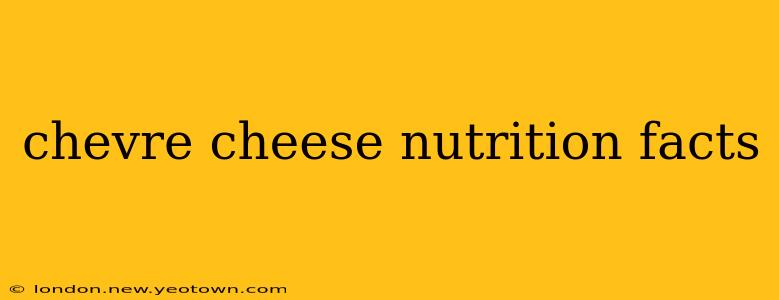Chevre, that tangy, creamy goat cheese, has captivated palates for centuries. But beyond its delightful flavor, what's the nutritional story behind this beloved cheese? Let's delve into the creamy depths and uncover the nutritional facts, addressing some frequently asked questions along the way.
What are the nutritional benefits of chevre cheese?
Chevre boasts a unique nutritional profile, differing slightly depending on the brand and preparation. Generally, it's a good source of protein, contributing to satiety and muscle maintenance. It's also rich in calcium, crucial for strong bones and teeth. Furthermore, chevre often contains a good dose of vitamin B12, essential for nerve function and red blood cell formation. Some varieties also offer a decent amount of vitamin A, important for vision and immune function. Finally, the high fat content in chevre, primarily saturated fat, shouldn't be disregarded. While moderation is key, saturated fat does play a role in hormone production and cell membrane health.
How many calories are in chevre cheese?
The calorie count in chevre varies. A typical serving (around one ounce) can range from 70 to 100 calories, depending on fat content and added ingredients. Those with added herbs, spices, or fruits will generally be slightly higher in calories. Always check the nutritional label on the specific brand you’re consuming for the most accurate calorie information.
Is chevre cheese good for weight loss?
The high fat content of chevre might make some wary of incorporating it into a weight loss plan. However, the protein and calcium content contribute to feelings of fullness, potentially reducing overall calorie intake. The key is moderation. A small serving of chevre, incorporated as part of a balanced diet, is unlikely to hinder weight loss efforts. Choosing lower-fat varieties can also help minimize calorie intake.
Is chevre cheese healthier than other cheeses?
Compared to some harder cheeses, chevre often has a lower sodium content and a slightly higher protein-to-fat ratio. However, "healthier" is subjective and depends on individual dietary needs and preferences. For those seeking a lower-fat option, some lighter chevres exist, although these might sacrifice some of the creamy texture. Ultimately, the "healthiest" cheese is the one that best fits within your overall dietary goals and preferences.
What are the potential downsides of eating chevre cheese?
While generally nutritious, chevre, like other cheeses, can be high in saturated fat. Excessive saturated fat intake can raise cholesterol levels. Furthermore, individuals with lactose intolerance may experience digestive discomfort, as chevre, while often easier to digest than some other cheeses, still contains lactose. Additionally, the salt content can be a concern for those watching their sodium intake. As always, moderation is key.
What are some ways to incorporate chevre cheese into a healthy diet?
Chevre’s versatility shines through in countless culinary applications. Spread it on whole-wheat crackers with sliced cucumbers and tomatoes for a light snack. Incorporate it into salads for a creamy, tangy twist. Use it as a topping for grilled vegetables or as a filling for baked potatoes. Get creative! The possibilities are endless. Consider pairing it with fruits like figs or grapes for a delightful flavor combination.
This exploration of chevre's nutritional profile paints a picture of a delicious and versatile cheese that can be a healthy addition to a balanced diet, when enjoyed in moderation. Remember always to check the specific nutritional information on your chosen brand and to listen to your body's signals. Bon appétit!

